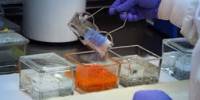As the popularity of these tiny fruits has grown, scientists have begun looking into the health advantages of goji berries. Their claimed advantages range from anti-aging to glucose management and immune function support. A tiny amount of dried goji berries on a regular basis may provide protection against age-related macular degeneration, the primary cause of vision loss in seniors.
Lycium barbarum is another name for goji berries. The goji berry is native to Asia, and Asians have been using this vividly colored fruit as a medicinal herb and food supplement for almost 2,000 years. According to small, randomized research done at the University of California, Davis, consuming a small quantity of dried goji berries on a regular basis may help prevent or delay the development of age-related macular degeneration, or AMD, in healthy middle-aged persons.
AMD is the main cause of vision loss in the elderly, affecting more than 11 million people in the United States and 170 million worldwide. “AMD impairs your central field of vision and can impair your ability to read or recognize faces,” said Glenn Yiu, a study co-author and associate professor in the Department of Ophthalmology and Vision Sciences.
Goji berries are high in antioxidants. Antioxidants are well-known for their immune-boosting properties as well as their capacity to combat free radicals and inflammation. Goji berries, like other berries such as blueberries and raspberries, are high in vitamins A and C. Vitamins A and C are essential for immunity and the prevention of ailments ranging from the common cold to cancer.
Our findings demonstrate that goji berries, a natural food source, can improve macular pigmentation in healthy participants in addition to high-dose nutritional supplements. Our next step in research will be to look at goji berries in patients with early-stage AMD.
Glenn Yiu
The researchers discovered that eating 28 grams (about one ounce, or a handful) of goji berries five times a week for 90 days boosted the density of protective pigments in the eyes of 13 healthy volunteers aged 45 to 65. In comparison, 14 study participants who took a commercial eye health supplement during the same time period did not demonstrate an increase.
The pigments lutein and zeaxanthin, which increased in the goji berry group, block out damaging blue light and give antioxidant protection. Both aid in the protection of the eyes as they age.
“Lutein and zeaxanthin are like sunscreen for your eyes,” Xiang Li, a doctoral candidate in the Nutritional Biology Program, stated. “The higher the levels of lutein and zeaxanthin in your retina, the better your protection. Our research discovered that even in normal healthy eyes, these optical pigments can be boosted with a small daily meal of goji berries,” Li added.
The findings were reported in the journal Nutrients.

Berries used for eye health in China
Goji berries are the fruit of two shrubby shrubs found in northwest China, Lycium Chinese, and Lycium barbarum. The dried berries are popular as a herbal beverage and as a component in Chinese dishes. They are consumed as a snack and are comparable to raisins.
Goji berries are considered to offer “eye brightening” properties in Chinese medicine. Li grew raised in northern China and became interested in whether “eye lightening” had any physiological properties.
“Because there are so many different sorts of eye illnesses, it’s unclear which one ‘eye brightening’ is targeting,” Li explained. She investigated the bioactive chemicals in goji berries and discovered that they contain significant levels of lutein and zeaxanthin, which are known to lessen the risk of AMD-related eye disorders. According to Li, the type of zeaxanthin in goji berries is also a highly bioavailable form, which means it is easily absorbed in the digestive system and used by the body.
The current treatment for intermediate phases of AMD involves the use of AREDS, which are dietary supplements including vitamins C, E, zinc, copper, lutein, and zeaxanthin. There is currently no known therapy that has been shown to have an impact on the early stages of AMD.
According to Yiu, the origin of AMD is complicated and multifactorial, involving a combination of inherited risks, age-related changes, and environmental variables such as smoking, food, and sun exposure. Although early stages of AMD are asymptomatic, physicians can discover AMD and other eye disorders during a routine comprehensive eye exam.
“Our findings demonstrate that goji berries, a natural food source, can improve macular pigmentation in healthy participants in addition to high-dose nutritional supplements,” said Yiu. “Our next step in the research will be to look at goji berries in patients with early-stage AMD.” Although the findings are encouraging, the researchers point out that the sample size was small and that more research is required.
















